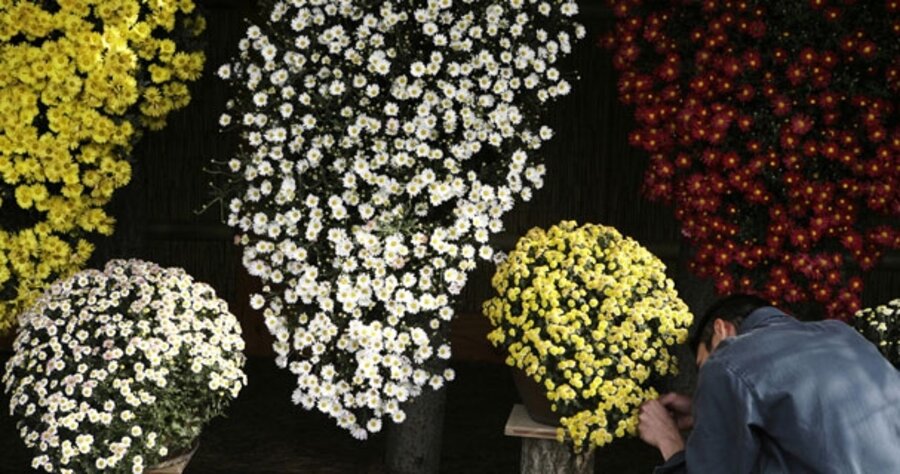The chysanthemum's star power
Loading...
Chrysanthemums, chrysanthemums. Those sun- or star-shaped flowers (an effusion of raylike petals radiating from the center) were everywhere, greeting me from doorstep pots, window boxes, and ledges as I walked my dog through my neighborhood on a recent fall day.
There were yellow chrysanthemums, dark-red chrysanthemums, golden chrysanthemums, even purple chrysanthemums. Like stubborn guests who refuse to leave the party, hardy chrysanthemums remain after summer flowers have departed November’s temperatures and waning daylight.
Does their ubiquity breed contempt? Or is there something more exotic behind the chrysanthemum’s apparently commonplace facade?
Ubiquity often means ready availability, and anyone who wants a chrysanthemum can acquire one easily this time of year. They can be found in plastic tubs at reasonable prices outside most supermarkets. After all, the chrysanthemum is the official flower of November, so it stands to reason that it’s everywhere.
Many items this familiar acquire a nickname, and the chrysanthemum is no exception. Most Americans know the plant exclusively by its three-letter nickname – the “mum.” But this simple sobriquet masks the complexity of this flower’s full identity.
That’s because the chrysanthemum is really two flowers in one. To some, the chrysanthemum (its name derived from the Greek words for golden and flower) appears ordinary.
Others, who were born of different cultural traditions, see the mum as mysterious, rarefied, even worthy of reverence.
Americans and Europeans usually consider the chrysanthemum as just a familiar and humble flower, appreciated because there often seems to be nothing much else flowering at this time of year.
Maurice Maeterlinck, the early 20th century Belgian playwright and essayist, emphasized the plant’s humility: “It is, among familiar plants, the most submissive, the most docile, the most tractable, and the most attentive of all that we meet on life’s long way.”
But to the Japanese, the chrysanthemum is something else again. In Japan, the flower (kiku in Japanese) evokes something close to awe. It is the symbol of the Japanese emperor. His throne is known as “the chrysanthemum throne” and his seal is an image of the flower.
The chrysanthemum is a frequent motif in Japanese art and textiles. The flower is the symbol of the Japanese Festival of Happiness. In Japanese society, the chrysanthemum plays a leading role, not just a bit part.
For nearly a thousand years, the Japanese have been cultivating and appreciating the chrysanthemum, which acquired an early association with longevity. Specially trained kiku masters are respected in Japan for their ability to train chrysanthemum plants into elaborate formations.
Not only do the Japanese embrace the standard mums found on American doorsteps this autumn, but they revere the more exotic specimens of the plant, including ozukuri, the large domed-shaped chrysanthemum with petals that curve upward.
But I must return from such chrysanthemum dreams to my own neighborhood. I wanted to see how the chrysanthemum would look in a formal garden a few blocks from my home.
I walked up the hill and paid admission to discover a new world of chrysanthemums, hitherto unknown to me. Entire garden rooms were devoted solely to the plant.
Though garden articles are published every fall about the variety of flowers available in autumn, the chrysanthemum prevails. I stood at the top of some steps and looked out over a sea of little suns and stars, a multihued crowd.
I have to admit that I like this flower, a kind of underdog plant in America. To me, the chrysanthemum is more valuable because it’s plain, like people who aren’t famous or important.
And like much else that we take for granted, the chrysanthemum – as the Japanese discern – has hidden dimensions and potential star power.
Given all these thoughts, I guess I shouldn’t have been too surprised when the doorbell rang the other day with a gift from a neighbor to thank me for rescuing her dog.
What autumn-hued flowering plant was presented and welcomed? Was it kiku – or merely a mum? Or was it both at once?





